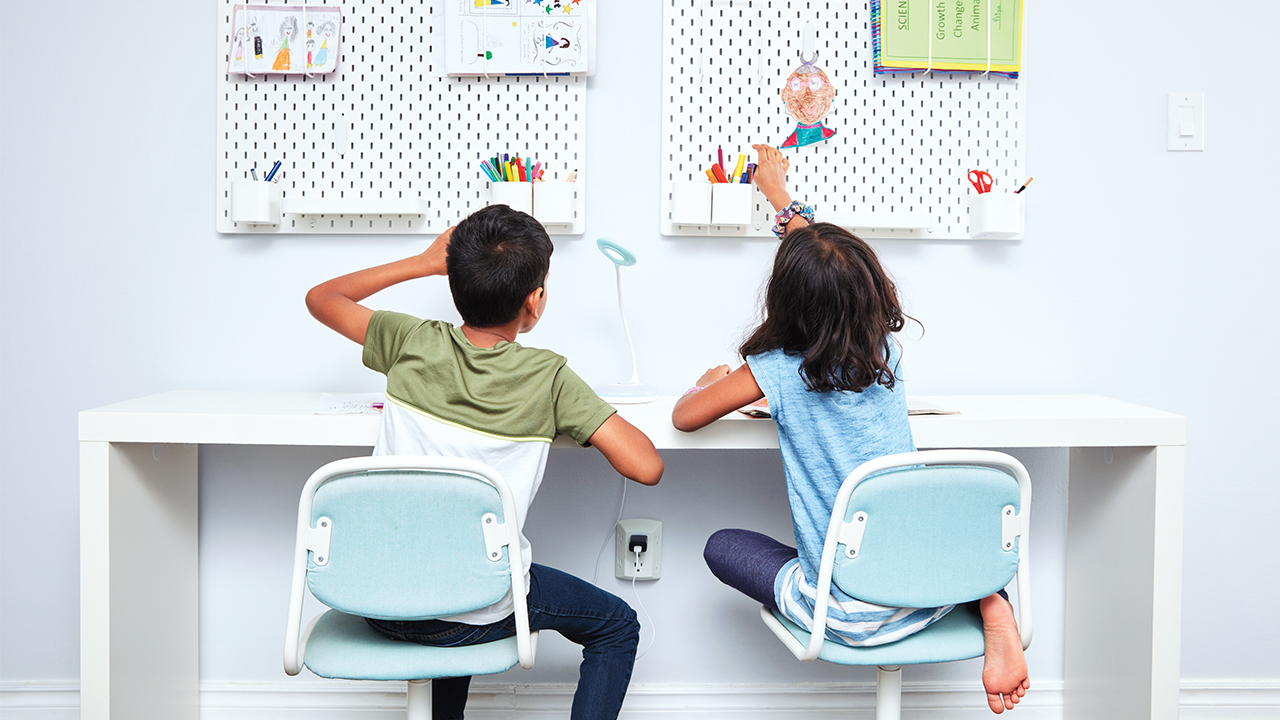In major Canadian cities, especially Toronto and Vancouver, families are increasingly living in tight quarters. Some parents are choosing to prioritize being able to walk to work, cafés, cultural centres and sports facilities—perks that were especially enticing pre-pandemic. As Annely Zonena, a project manager in Strategic Initiatives in Toronto’s City Planning Division, describes it, “You get a pass to the Royal Ontario Museum and that can become a weekly excursion for your children. The richness that access to cultural facilities and great-quality parks provides families is something that people are often willing to trade for a quieter life with a yard.”
But many parents don’t see their small-living footprint as a choice. They can’t afford detached or semi-detached homes in the city they work in. And it’s not possible for them to commute from the office to the suburbs and still make the child-care pickup time. So a condo, apartment or compact townhome can be the only option. The most recent data from the Toronto Regional Real Estate Board puts detached and semi-detached homes at $1.5 and $1.2 million respectively, while the average price for a two-bedroom Toronto condo is between $650,000 and $900,000. Rent for a house can cost $4,000 a month, while a two-bedroom condo is averaging $2,700. It’s not surprising, then, that according to a City of Toronto report conducted over ten years, 15,000 more households with children were living in high-rise buildings.
Photo: Carmen Cheung
Parents who work in Vancouver are feeling the squeeze, too. While around 80 percent of Vancouver’s young families would have bought a detached home if it were possible for them, around a quarter of families purchased attached units and 17 percent bought condos, according to a survey by Mustel Group for Sotheby’s International Realty Canada.
And the trend isn’t going away. Buildings five stories and higher now represent 94 percent of all new residential housing developments in the fast-growing city of Toronto. That’s why Zonena and her colleagues embarked on a two-year project in 2015 that sought to understand the needs of families living in mid- and high-rises. In addition to calling for more two- and three-bedroom units, the Growing Up: Planning for Children in New Vertical Communities report also suggests things like storage for skates, scooters and boots in the entranceway, laundry sinks in units, and amenity rooms that allow for communal eating and messy play.
In their interviews with families, Zonena expected they’d discover tons of “hacks,” like desks that turn into beds. Instead, they found that “people were hacking their expectations of what they needed to live a comfortable life.” From cutting down on stuff to spending more time together, living in a small space comes with philosophies on parenting that can benefit all families. We talk to three households about the challenges, how they’re making it work, and why they’re staying put, even when a pandemic means they’re seeing more of their four walls than they’d ever imagined.
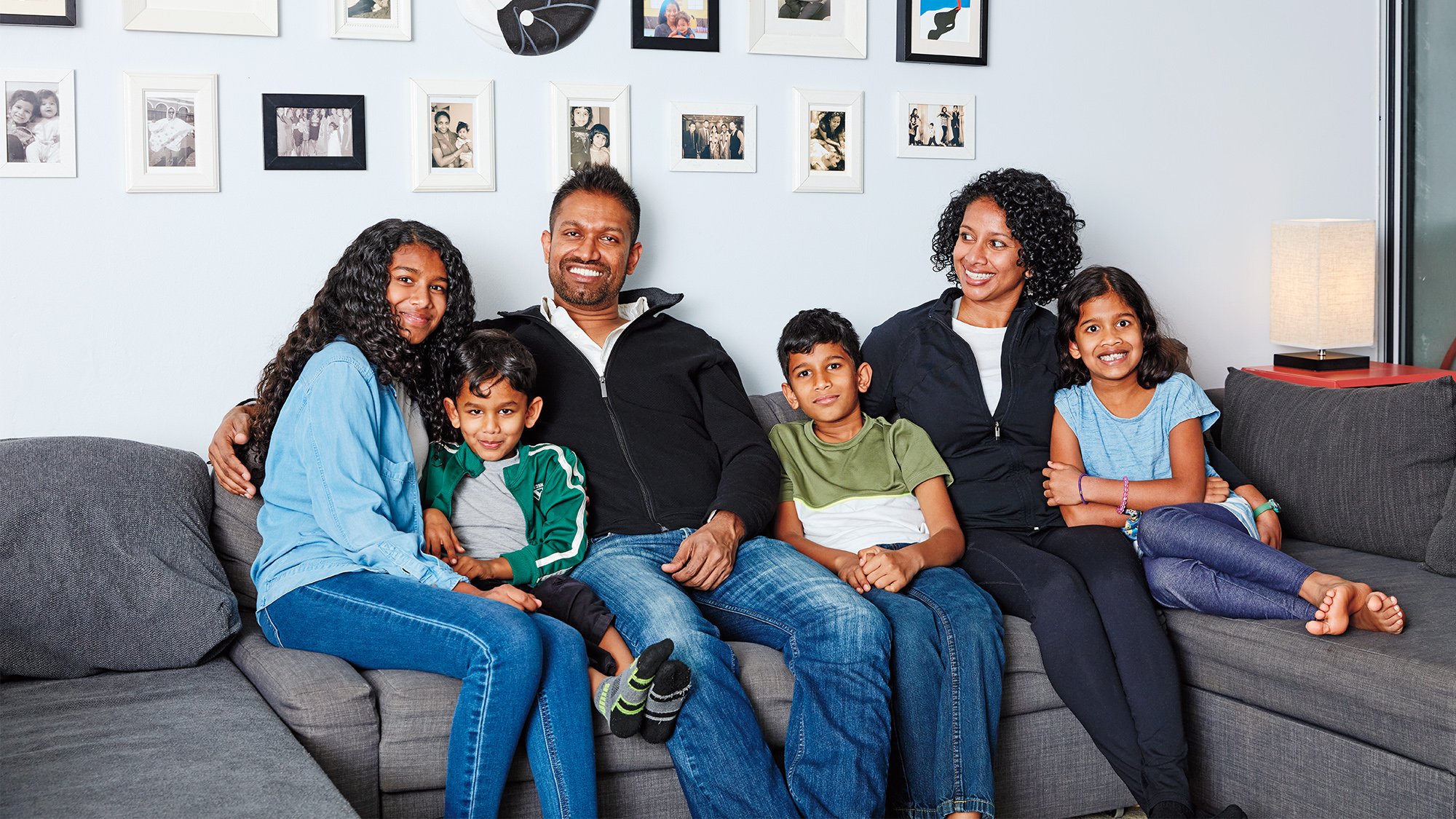
Photo: Carmen Cheung
Gaya and Naren Navaratnam, Leela, 13, Ruben, 10, Priya, 7, and Logan, 4
800-square-foot two-bedroom condo, Toronto
When expecting their fourth child, Gaya and Naren Navaratnam saw a unit come up on the market that offered more space, so they sold their one-bedroom condo and bought a two-bedroom one. Located near College and Yonge in the heart of downtown, it’s a five-minute walk from the kids’ school and an eight-minute walk from Naren’s office, and it’s also near other attractions like Riverdale Farm and the Art Gallery of Ontario.
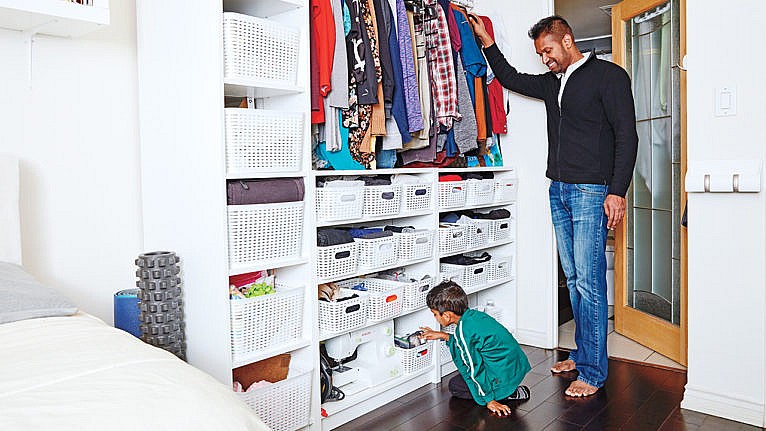
Organization is key to making small-space living work. The Navaratnams use closet storage baskets to organize belongings so everyone knows where things go and tidying up is a breeze. Photo: Carmen Cheung
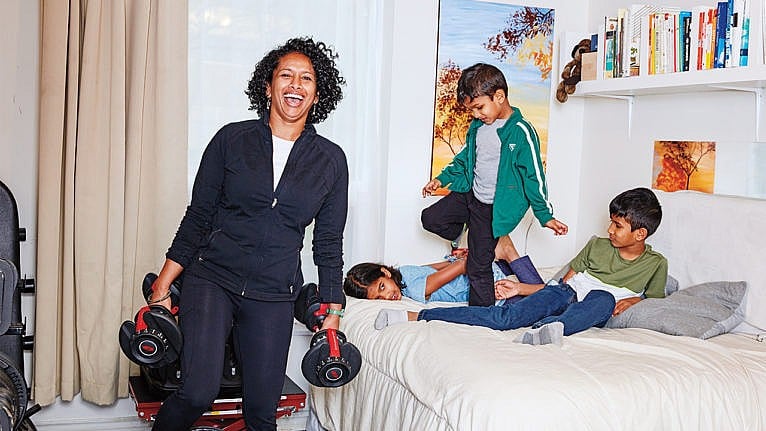
Gaya, with her mini motivators, conducts virtual personal training sessions geared toward moms. Photo: Carmen Cheung
Fast-forward four years, COVID-19 hit and their 800-square-foot home was suddenly even more lively. Gaya transitioned her personal training business to virtual services, and Naren, a software developer, began working full-time from home. Meanwhile, they were overseeing online schooling for their kids. Their building’s swimming pool, which they’d been using weekly, closed, and they could no longer fill their time at jiu-jitsu lessons or on family trips to the art gallery or museum. So they instigated virtual chess tournaments with extended family. They also started family “Fight Club” nights at home, where they play-fight and practise martial arts. “Everyone loves it. We often incorporate self-defence videos from YouTube,” says Naren.
Of course, the pandemic made living harmoniously “a little more challenging,” says Naren. Their usual biweekly family meetings were required twice a week to refine a schedule that worked for everyone. In one of these meetings, their eldest again made her case for privacy from her brothers, and Gaya and Naren agreed. So they moved the two sets of bunk beds out of the master bedroom, where all four kids were sleeping. The boys now sleep on the pullout sofa in the living room, which they love. And they turned the smaller bedroom into a girls’ room, with two bunk beds and a trundle bed on the lower bunk for future sleepovers. Gaya and Naren converted the master into their own sleep, work and hangout space, fitting a desk in the closet. It’s where they retire to once the boys fall asleep in the living area.
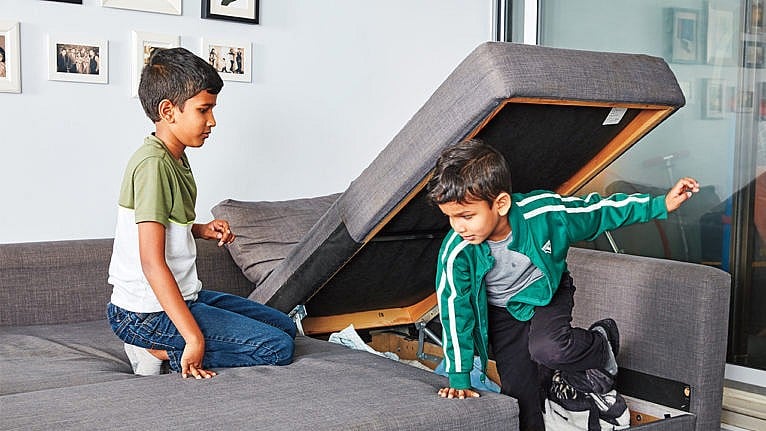
Each morning, the boys neatly pack away their bedding and the living room goes back to being a communal space. Photo: Carmen Cheung
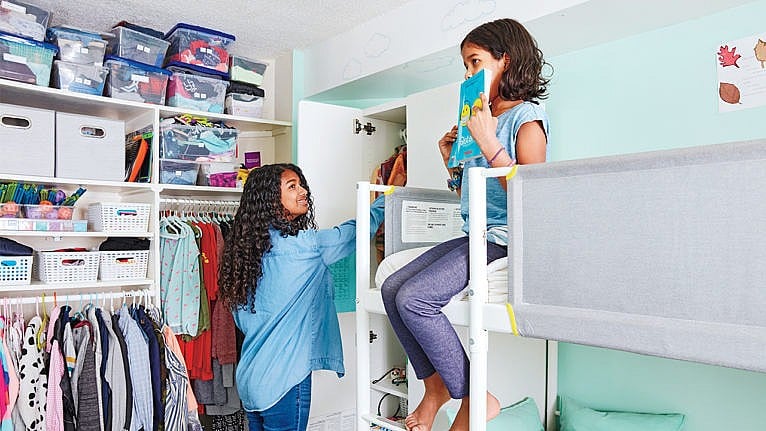
At a family meeting, their eldest, Leela, made a case for more privacy, earning the girls their own room. Photo: Carmen Cheung
Gaya and Naren say democratic decision-making is key to raising kids in a small space. Their kids have learned to respect everyone’s needs. “There’s always been someone who needs to nap,” says Gaya. They’re all used to making their beds every morning (or folding their bed away) and they try to live by the rule that when they bring in a new toy, an old one goes out. It helps that there’s a donation table right in the building. “I don’t like clutter. Everything needs to have a home for me, and I think it’s good for kids to have that sense,” Gaya says.
Living in tight quarters has made the kids more independent. “They’ve always been able to see what we’re doing, whether it’s cooking or exercising,” says Gaya, and they often join in.
But for Gaya and Naren, the benefits of living small are bigger than tidiness. Gaya wanted to be able to stay at home with all their kids in their first few years, and a manageable mortgage made surviving on a single income possible. Plus, the lack of a commute means that, in non-pandemic times, Naren is home just after four. “We were commuting from the suburbs when we lived with our parents, before we had kids. It was roughly three hours a day and by the time I was home, I was exhausted. Now, I’m home and I’m energetic. I’m ready to do stuff with the kids,” Naren says.
Such close quarters help Gaya and Naren see what the kids are up to. “It brings up more opportunities to discuss stuff,” says Naren.
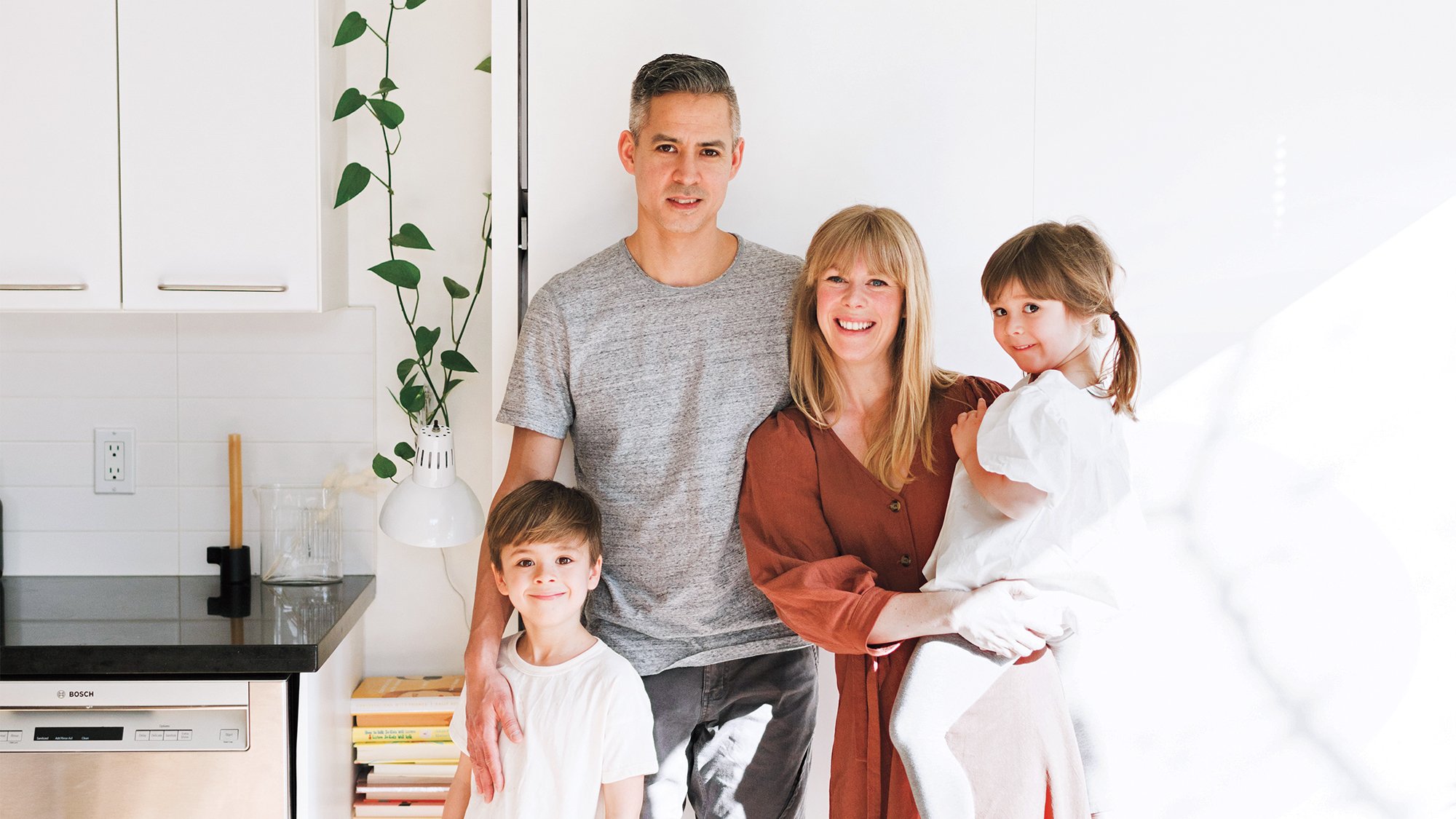
Photo: Amy Highton
Alison and Trevor Mazurek, Theo, 7, and Mae, 4
600-square-foot one bedroom condo, Vancouver
When Alison Mazurek and her husband, Trevor, had their first child, everyone expected them to move out of their high-ceilinged and light-filled one-bedroom condo in the Mount Pleasant neighbourhood of Vancouver. But the thought of commuting wasn’t appealing. So Alison began to research how to raise a kid in a limited space. She discovered inspirational photos of families in apartments in places like New York City and San Francisco and many European cities, but, she says, “I couldn’t find a lot of people explaining how it works.” So she decided if she could figure it out, she’d share her tips.
Now, still living in the same one-bedroom condo, Alison blogs about her family’s storage and furniture hacks, and interviews small-space parents around the world. She’s noticed more people are opting to live small, including people in Canadian cities.
One key piece of advice that Alison frequently shares with like-minded parents is to hand over bedroom space to kids, be it the only bedroom or the larger of two bedrooms. She and her husband sleep on a wall bed while her seven-year-old son and four-year-old daughter share the bedroom. “Adults really just need a nice bed with nice sheets and maybe a lamp. But kids need room to play and be creative and imaginative,” she says.

In their shared bedroom, the kids sleep on a wall bunk bed that can be folded up to create more floor space. Photo: Alison Mazurek
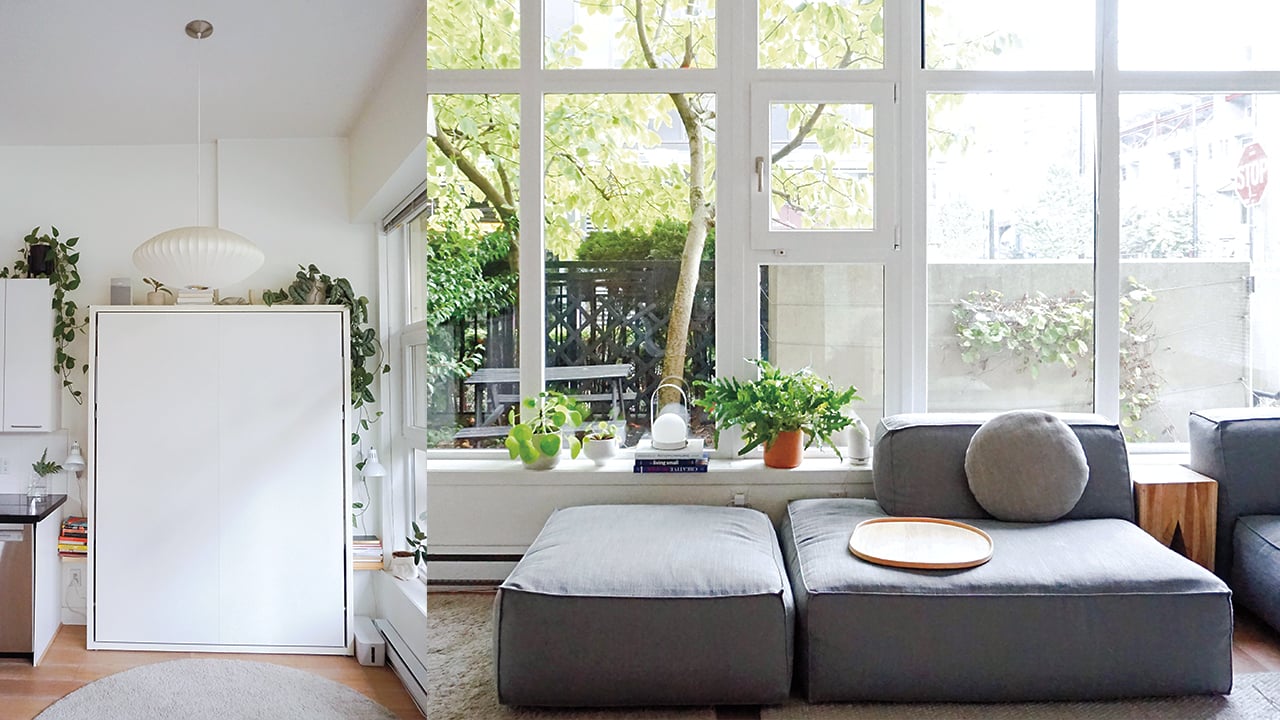
The Mazureks invested in a condo with high ceilings and a wall of windows, which gives the illusion of more space and can accommodate their wall bed, which is located right off the kitchen and can be tucked away each morning. Other furniture is kept light and minimal like this modular sofa from Article that allows them to easily reconfigure the space. Photo: Alison Mazurek
There are other widely perceived staples that the Mazureks live without. They don’t have a coffee table because it would take up extremely valuable play space. Instead, they have a couple of tiny side tables that they move for drinks as needed. And they’ve eschewed desks and kids’ tables. “The dining table is the eating table, the art table, the school table, the everything table,” she says.
Alison thinks her kids, despite having different temperaments, get along better because of the close quarters. With nowhere to go, “they have no choice but to work out their differences and share.” Still, she’s seeing that they’ll need their own space as they get older. On top of that, pandemic life has made a bigger space especially attractive. “There are these wonderful trade-offs to living small, like the freedom to travel,” she says. But when extra money for travel and the proximity to cute cafés down the street are no longer an advantage, “then you kind of have to re-evaluate.”
“Adults really just need a nice bed with nice sheets and maybe a lamp,” says Alison. “But kids need room to play and be creative and imaginative.”
Alison and Trevor aren’t looking for a house outside the city, though; instead, they’re looking for a two-bedroom nearby. Each child would have their own room while Alison and Trevor are happy to continue with their wall bed arrangement. Among their criteria for the next place: All the space must be usable—“no awkward or dead spaces that would be difficult to find uses for.”
Although the pandemic has made them question their square footage, it’s also revealed some advantages to their limited footprint. For one, it gave them a financial buffer when schools were closed and Alison had to reduce her hours, one they wouldn’t have had with a big mortgage. Plus, living small has meant that they’re “always taking stock of what’s most important,” she explains. For her family, that’s spending time together, getting outside and being creative. That “minimalist, essentialist approach to life,” as Alison calls it, “can come in really handy in a crisis.”
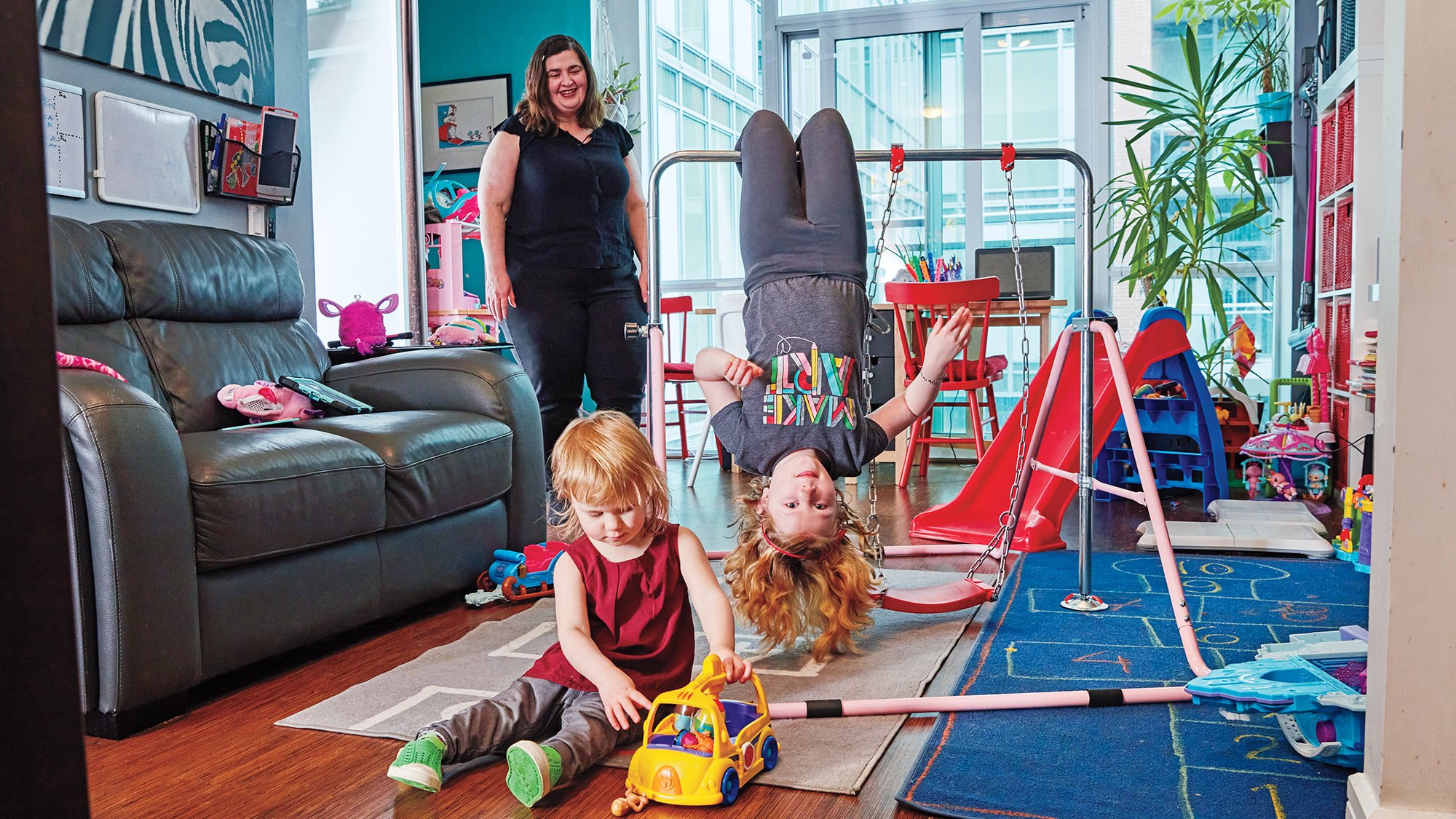
Photo: Carmen Cheung
Andrea Goguen, Bianca, 7, and Talia, 2
650-square-foot one-bedroom + den condo, Toronto
As a single parent who works downtown, Andrea Goguen always planned on raising kids in a condo. Pre-pandemic, it meant she could spend an extra hour or two with her children every day, compared to if she were commuting from the suburbs. Plus, she had exercise built into her busy day. “My commute was a 30-minute walk, including drop-off at school and daycare, so I was guaranteed an hour of exercise a day,” she says.
She also appreciates not having to spend her already stretched time on maintaining a yard or cleaning a house. Her building has two yoga studios, one of which, pre-pandemic, had scheduled hours for kids in the building to play with toys and roll around on exercise balls together. They’re also surrounded by parks. “We have St. James Park, we have ‘red park’, we have secret park,” says Andrea, referring to a play structure tucked away in a nearby building’s courtyard.
Since March, Andrea has been overseeing virtual school and working from home, so she’s had to dramatically change up the daily routine. To keep the kids active during the day, she purchased an indoor swing that doubles as a gymnastics bar for Bianca, 7, who does flips on it. Though it takes up most of the living room, it folds away when it’s not in use. The kids also like to ride their bikes around the locker room hallway loop. (Sometimes they play jail with a few empty lockers.)
There was enough room for a Barbie house or a dresser in the den, so Bianca, naturally, chose a Barbie house.
Andrea does her day job providing support for investment banking transactions at the kitchen table, where her seven-year-old sits for her virtual school. “If she’s struggling, I get up and help her with something in a way that’s no different than helping a colleague,” says Andrea. The tough part is conference calls. “It’s hard to pay attention to a meeting if Bianca has her online class at the same time,” she says.
Talia, meanwhile, does her own thing for the most part. Andrea hides toys and brings out a “new” one each morning to keep her engaged. And she’s organized the toys so that if she does dump out a bin or two, it’s easy to clean up. “All the Barbies go back in the Barbie bin and all the crayons back into their containers.” Sometimes Talia likes to sit on Andrea’s lap if she’s having a virtual meeting, to look at her colleagues, and sometimes she sits in on Bianca’s class. When needed, there’s always Peppa Pig.
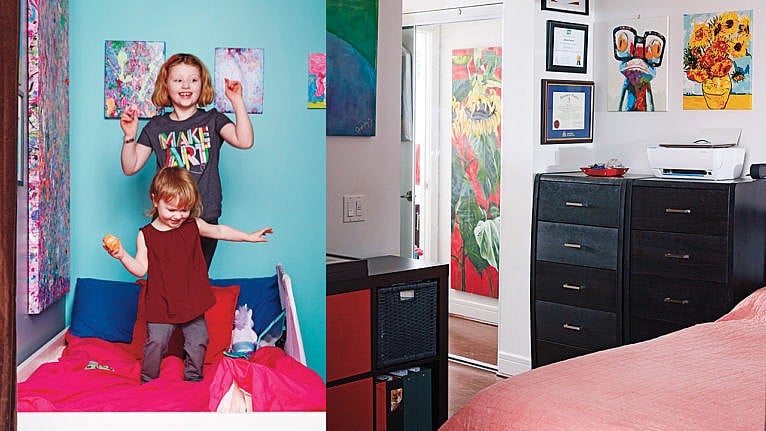
When Talia gets older, Andrea will swap out Bianca’s twin bed in the den for a bunk bed. Large dressers in the main bedroom contain everyone’s clothes and are located conveniently close to the bathroom and laundry room. Photos: Carmen Cheung
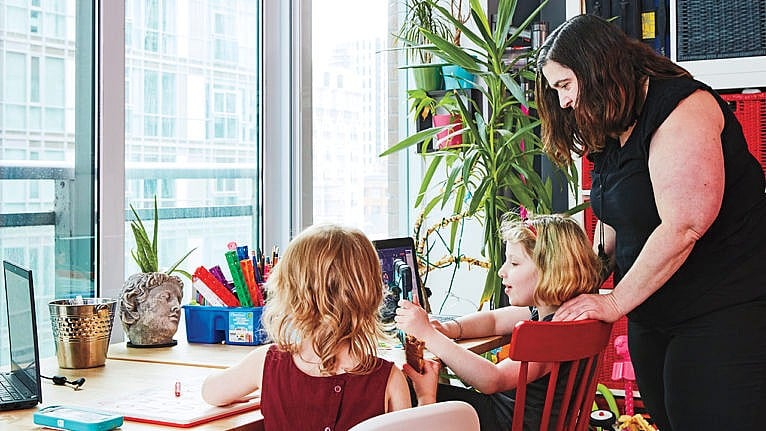
The Ikea Norden table has two fold-out work surfaces and is set up in front of the floor-to-ceiling windows where Andrea is able to work while Bianca does virtual learning. Photo: Carmen Cheung
As for all the stuff that comes with baby- and toddlerhood, Andrea has realized she can make do without some of the “must-haves.” She sold the crib when Talia was finished with it, used a fold-up changing mat instead of a table, and she ships Talia’s hand-me-downs to a friend nearby with a baby. Bianca’s good-quality clothes get labelled and put in bins in the storage locker.
For now, Talia falls asleep in the bed with Andrea, and Bianca sleeps in a twin bed in the den. (When Talia’s ready to sleep on her own, Andrea will switch up Bianca’s single for a bunk bed.) There was enough room for a Barbie house or a dresser in the den, so Bianca, naturally, chose a Barbie house. The dressers are in the master bedroom, right beside the bathroom and laundry. “It’s easier because everything is put away in one spot,” she says.
While Andrea expects she’ll move up to a two-bedroom condo in the next few years, for now the arrangement works. Her seven- and two-year-old, she says, “are so tight,” and Bianca is “a huge helper,” especially with potty training. “Talia gets more out of Bianca being proud of her than with me,” she says.
Andrea purges unneeded baby and kid items—like the potty—frequently. Every week she’s posting something the youngest has grown out of, she says. “Living in a smaller space means you have to stay on top of stuff, but there’s good in that.”
